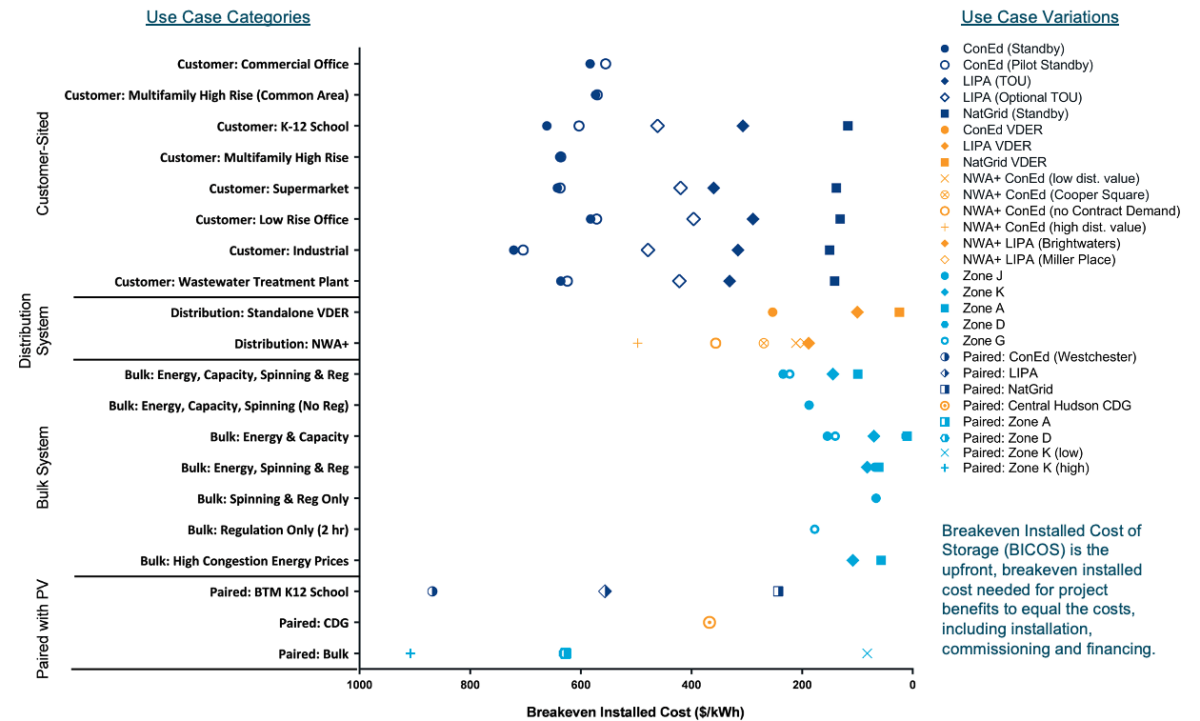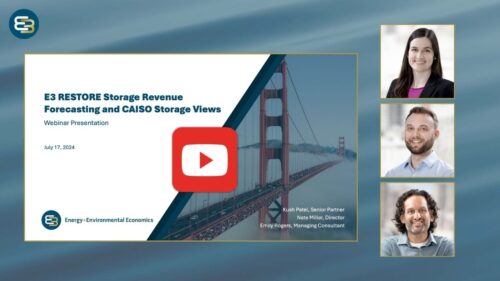Overview
RESTORE is E3’s price-taker optimization model, designed to evaluate the value of distributed energy resources (DERs) in the transition to a low-carbon, high-renewables grid. It has been utilized to assess both behind-the-meter and front-of-the-meter DER technologies, including storage technologies, in applications such as asset valuation, cost-benefit analyses, market operation simulations, utility retail rate design, and adoption modeling. A diverse set of clients, including utilities, government agencies, developers, and investors have employed RESTORE.
- Utilities and Load Serving Entities (LSEs) use RESTORE to evaluate the cost-effectiveness of a wide range of DERs to support planning, filing, and obtaining regulatory approval for DER programs and initiatives. These programs have assisted entities like National Grid and PG&E in various use cases, including retail rate design, DER planning, DER benefit-cost analysis, DER adoption forecasts, and non-wire alternatives.
- Government agencies such as the California Public Utilities Commission , California Energy Commission , and New York State Energy Research and Development Authority use RESTORE for policy implication analysis, ratepayer impact assessments, and benefit-cost analysis.
- Developer and investor clients utilize RESTORE to assess market entry strategies, cost of ownership, and asset and portfolio valuation.

RESTORE can assess a wide range of technologies, as shown above. The range spans both behind-the-meter and front-of-the-meter DER technologies, including storage technologies, in applications such as asset valuation, cost-benefit analyses, market operation simulations, utility retail rate design, and adoption modeling.
RESTORE maximizes the net benefits of flexible DER dispatch as price-takers, subject to technology operating constraints, federal, state, city, and utility program requirements, and market rules. It is designed to co-optimize customizable value-stacking opportunities among DER portfolios, allowing solar, storage, and other generators to work together to maximize net benefits. RESTORE supports flexible optimization windows (daily, monthly, annually) and intervals (hourly, 15 minutes, 5 minutes). The model also supports different dispatch perspectives—customer-control cases optimize retail rate savings, utility-control cases optimize system avoided costs or greenhouse gas emission reductions, and joint-control cases balance both customer and utility objectives. At E3, RESTORE has been employed for numerous use cases that can be categorized into three groups corresponding to E3’s practice areas: Asset Valuation, Integrated System Planning, and Climate Pathways & Electrification.
Asset Valuation Example: Energy Storage Valuation
E3 has evaluated a wide range of project configurations (standalone, hybrid, co-located) and energy storage technologies in many major U.S. markets (WECC, ERCOT, NYISO, ISONE). E3 has supported investors (debt, equity, and tax equity), project developers, and off-takers with investment-grade revenue forecasts and market advisory services that have led to billions of dollars of deployed capital in energy storage projects to date.
 Front-of-the-meter storage revenue forecasting is one specific application of the RESTORE model. As the machine behind E3’s storage asset revenue forecast offerings, RESTORE simulates the revenue and operations of storage assets, providing valuable insights for a wide range of clients, including developers, investors, asset owners, trade associations, and other industry stakeholders. RESTORE is designed to model various storage technologies, such as lithium-ion batteries, pumped hydro, flow batteries, and compressed air energy storage. It is also capable of modeling storage technologies paired with intermittent resources like solar or wind energy.
Front-of-the-meter storage revenue forecasting is one specific application of the RESTORE model. As the machine behind E3’s storage asset revenue forecast offerings, RESTORE simulates the revenue and operations of storage assets, providing valuable insights for a wide range of clients, including developers, investors, asset owners, trade associations, and other industry stakeholders. RESTORE is designed to model various storage technologies, such as lithium-ion batteries, pumped hydro, flow batteries, and compressed air energy storage. It is also capable of modeling storage technologies paired with intermittent resources like solar or wind energy.
The model optimizes storage operation across multiple revenue streams with perfect foresight, allowing users to forecast either single or multiple revenue streams. It minimizes net costs, subject to battery technology and market constraints, including state of charge, number of cycles per year, market bidding rules, and round-trip efficiency, among others.
For front-of-the-meter projects, RESTORE considers utility-controlled storage assets that face market price signals. The model stacks customizable revenue streams such as capacity, energy, and ancillary services revenue.

The graph above presents the dispatch chart of a front-of-the-meter battery during the spring in California. The battery participates in the Day-Ahead SP15 CAISO market with a Resource Adequacy Call at hours 15 and 16. The battery provides regulation services in most of the hours due to the high regulation services price, and discharges to provide capacity for the system under the Resource Adequacy program hours.
Integrated System Planning Example
RESTORE leverages E3’s industry-leading expertise in DER analyses to fully capture the local distribution and ratepayer impacts of behind-the-meter DER technologies. RESTORE can be used to determine optimal storage dispatch schedules for standalone storage systems, paired solar+storage, and various other DERs.
The model calculates optimal energy storage system charging and discharging schedules, as well as the load reduction or shifting behavior of other DERs, on an 8760 hourly basis. It maximizes total net revenue across the multiple value streams that DERs can provide, while monitoring the state of charge and honoring any operational constraints that may limit a resource’s ability to provide more than one service simultaneously. Dispatch modeled with RESTORE can be optimized according to either:
- Customer rates (such as time-of-use rates), to align most closely with DER behavior as optimized from a customer’s perspective.
- Hourly avoided costs (as developed in previous workstreams) or greenhouse gas emission reductions, to represent DER behavior if optimized by a utility to minimize energy supply costs.

E3 worked with a senior-level Department of Public Service (DPS) and NYSERDA teams to support the development of a first-of-its-kind Energy Storage Roadmap for New York State. The team used RESTORE to perform in-depth economic analysis of a broad range of storage project configurations and use cases across customer, distribution and bulk system market segments. E3’s analysis was central to developing the Roadmap’s policy, regulatory, and programmatic recommendations.
Climate Pathways & Electrification Example: EV VGI Valuation
E3 has used RESTORE to model the value of electric vehicle-to-grid integration (VGI), including managed charging, bi-directional charging and discharging, and interactions with other technologies such as behind-the-meter solar and storage. E3 has analyzed a wide range of use cases including vehicle-to-home (V2H), vehicle-to-building (V2B), vehicle-to-microgrid (V2M), and vehicle-to-grid (V2G). We have supported a diverse group of clients in this sector, including automakers, EVSE companies, policymakers, EV aggregators, and more.
RESTORE considers data inputs like customer load, customer driving profiles, vehicle and charger parameters, and retail rates to make optimal decisions about when and how much the EV should charge or discharge to support driving needs and customer load. We model the EV under unmanaged charging, managed charging, and V2X-enabled charging scenarios to assess the benefits of shifting load and discharging energy back to meet the customer’s load. Key outputs include customer bill savings from managing or supporting load, providing resiliency during outages, and exporting energy to the grid, depending on the use case.

E3 estimates the economic and operational benefits of bi-directional EV charging and discharging supporting microgrid operations, particularly during outage days, to enhance overall microgrid resilience. Using RESTORE, E3 analyzed how bi-directional EV capabilities could optimize energy flow within a microgrid. The project assessed scenarios where EVs contribute power to critical loads during grid outages, providing insights into potential cost savings, improved grid stability, and enhanced energy reliability.
Discussion and Q&A on RESTORE
E3’s Emily Rogers, Nathan Miller, and Kush Patel recently hosted a webinar on RESTORE, including a discussion on our views on California’s energy storage market. The recording is available in full below.
All Tools



